Well, okay, a little west of North. Destination: the Giant’s Causeway. Getting there would have been easy, if we’d had an Internet connection and could dial up Google maps (or whatever); but all we had was the AA Road Atlas of Ireland, which was fine for general directions (M3, M2, A26 …), but deficient when it came to a map of Belfast: there was one, but we weren’t on it.
So, we took totally the wrong direction (with the benefit of hindsight!), roughly 180º wrong, in fact; but we wombled around as usual, and eventually found the right route.
Once we’d got under way, the drive took about two hours. In southern Ireland, we’d seen several houses flying flags with the local county colours: the yellow and green of Kerry; the red and white of Cork; the blue and white of Waterford … In Ulster, our route took us through some extremely neat villages festooned with Union Jacks and St George flags, like bunting for a royal visit. Regrettably (in hindsight), we didn’t stop for a photo.
We also didn’t stop to photograph any of the bands of very heavy rain that were sweeping across from west to east. We must have passed through four or five of them, each one requiring us to slow down, turn on the headlamps, and put the windscreen wipers on full. We thought of the floods there’d been down south (and not very far down south, really) the day before …
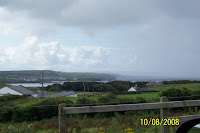
We got to the Giant’s Causeway about 1 p.m., during a dry (non-raining) and even partially sunny spell. Despite the weather, there was a long queue for parking, during which we took some very atmospheric photos of the weather sweeping across the mouth of Lough Foyle. Fortunately, we managed to dodge it when it fell.
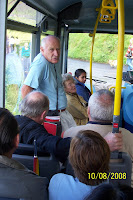 You have to pay to visit the Causeway itself, which we duly did, and that entitled us to use the courtesy bus (which was
You have to pay to visit the Causeway itself, which we duly did, and that entitled us to use the courtesy bus (which was yellow). It’s quite a long way down to the beach, and along the way we had official guide Colin to regale us with myths and legends—and some real geology—about the Causeway and its origins. The ride down alone was pretty scenic, taking us past (amongst other attractions) Finn MacCool’s stone camel and his petrified granny (who overdid it one day at the Bushmill’s distillery. Colin later admitted to us that he’d made that bit up).
yellow). It’s quite a long way down to the beach, and along the way we had official guide Colin to regale us with myths and legends—and some real geology—about the Causeway and its origins. The ride down alone was pretty scenic, taking us past (amongst other attractions) Finn MacCool’s stone camel and his petrified granny (who overdid it one day at the Bushmill’s distillery. Colin later admitted to us that he’d made that bit up).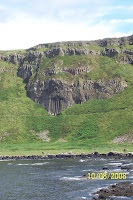
We learnt from Colin that the Causeway, and related formations in Ireland and Scotland, was made (or its foundations laid) 60 million years ago, when volcanic eruptions filled river valleys with lava which cooled and solidified. Where it cooled slowly and evenly, it formed the hexagonal pillars that everyone knows about at the Causeway; where it cooled rapidly, it left chaotic jumbled masses. You can see where pillars meet chaos in the cliffs to the east of the Causeway.
The locals know that this is just a modern myth, of course; the truth of the matter is that the Giant of the Giant’s Causeway was none other than the aforementioned Finn MacCool, whom we previously met on the Dingle Peninsula. Though he fought many battles in many parts of Ireland, hereabouts was his actual home, and the story is well known of how he built the causeway so that a rival Scottish giant, Benandonner, could cross the sea to be whomped.
 But as big Ben approached, Finn realised to his horror that his opponent was a larger and more fearsome rival than he anticipated. He fled to his home in the nearby hills, and like any sensible man, asked his wife for advice. Oonagh, a practical woman, disguised Finn as a baby, complete with large nightgown and bonnet. She placed him in a huge, hastily made cradle, telling him to keep quiet and pretend to sleep, as Benandonner’s
But as big Ben approached, Finn realised to his horror that his opponent was a larger and more fearsome rival than he anticipated. He fled to his home in the nearby hills, and like any sensible man, asked his wife for advice. Oonagh, a practical woman, disguised Finn as a baby, complete with large nightgown and bonnet. She placed him in a huge, hastily made cradle, telling him to keep quiet and pretend to sleep, as Benandonner’s  great shadow darkened the door. Oonagh brought the Scottish giant in for tea, pleading with him not to waken Finn’s child, Looking at the massive ‘baby’ lying in the cradle, Benandonner took fright, saying that if this was the child, he had no wish to meet the father. He fled back to Scotland, ripping up the Causeway behind him, terrified that the awful Finn might follow him home.
great shadow darkened the door. Oonagh brought the Scottish giant in for tea, pleading with him not to waken Finn’s child, Looking at the massive ‘baby’ lying in the cradle, Benandonner took fright, saying that if this was the child, he had no wish to meet the father. He fled back to Scotland, ripping up the Causeway behind him, terrified that the awful Finn might follow him home.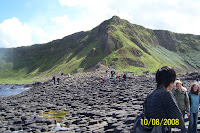
(According to Colin, who actually seemed to know what he was talking about re the geology, the “matching” formations in the Hebrides, including Fingal’s Cave—“Fingal”, a.k.a. Finagle, being Finn MacCool—are from a different lava flow of about the same period, and not directly linked to the Giant’s Causeway.)
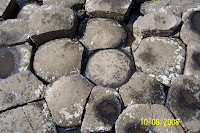 We clambered (and sat) on the Causeway, fascinated not just by
We clambered (and sat) on the Causeway, fascinated not just by  the scale of the thing, but by its fine detail. There are, of course, “features” to look out for, such as The Wishing Chair (made for Finn when he was a child, it will grant your wish if you sit in it), but Don was intrigued by “Finn’s patio paving” and “Finn’s patio pool”, never previously described …
the scale of the thing, but by its fine detail. There are, of course, “features” to look out for, such as The Wishing Chair (made for Finn when he was a child, it will grant your wish if you sit in it), but Don was intrigued by “Finn’s patio paving” and “Finn’s patio pool”, never previously described …
 The weather was still sunny, despite a couple of spits of rain, and we spent some time on the main Causeway (there are three parts; the photo shows the Wishing Chair on Middle Causeway) before catching the bus back up to the Visitors’ Centre at the top of the
The weather was still sunny, despite a couple of spits of rain, and we spent some time on the main Causeway (there are three parts; the photo shows the Wishing Chair on Middle Causeway) before catching the bus back up to the Visitors’ Centre at the top of the cliffs. There we shopped for magneti (found a good one of the Causeway), a bookmark (ditto), the inevitable guide books, and—at last—the very T-shirt we’d wanted for Don in Killarney, but been unable to get in the right size. No cross-stitch, but Margaret found one later on the Internet. And we sat and leafed through the booklets while we had another very late lunch.
cliffs. There we shopped for magneti (found a good one of the Causeway), a bookmark (ditto), the inevitable guide books, and—at last—the very T-shirt we’d wanted for Don in Killarney, but been unable to get in the right size. No cross-stitch, but Margaret found one later on the Internet. And we sat and leafed through the booklets while we had another very late lunch.
Colin’s reference to Finn’s Granny’s love of Bushmills whiskey was an apt local reference. Ireland once had many thriving whiskey distilleries, but thanks to astute marketing and large-scale production, inferior Scottish whisky flooded the worldwide market, and Irish whiskey had to struggle to catch up. The spelling with an “e” was adopted in the 1870s to mark the distinction, but economic difficulties caused the closure and merger of many distilleries, so that Ireland now has only three to the ninety or so in Scotland (which all have improved immensely since the 19th Century). And one of them is at Bushmills, five miles to the south of the Causeway.
astute marketing and large-scale production, inferior Scottish whisky flooded the worldwide market, and Irish whiskey had to struggle to catch up. The spelling with an “e” was adopted in the 1870s to mark the distinction, but economic difficulties caused the closure and merger of many distilleries, so that Ireland now has only three to the ninety or so in Scotland (which all have improved immensely since the 19th Century). And one of them is at Bushmills, five miles to the south of the Causeway.
Don has a taste for peaty malt whiskies, which we indulged while in Scotland, coming back with both peaty Islay whiskies, and smoother Highland and Speyside whiskies, so we could both educate our palates. But neither of us had ever tried Irish whiskey (incredible as it might seem), so now was our chance.
We got to Bushmills (the name of the town, as well as the distillery—it’s on the River Bush, probably an old Celtic name) about four in the afternoon, just in time to miss the last distillery tour; but we’d toured the Aberfeldy distillery in Scotland, and weren’t too disappointed. Instead, we made our way to the shop and the Distillery Kitchen Restaurant in the hope of a tasting. There we had a treat: a tasting tray, with four whiskeys (two blends and two malts), arranged on a leaflet which explained what they were and what you should expect to smell and taste. We both enjoyed the flavours (and Margaret enjoyed her cheesecake); in the shop afterwards, we bought a Bushmills fridge magnet, half-bottle samples of several whiskies, and a Glencairn tasting glass to complement the one we’d bought at Glenfiddich in 2007.
tour; but we’d toured the Aberfeldy distillery in Scotland, and weren’t too disappointed. Instead, we made our way to the shop and the Distillery Kitchen Restaurant in the hope of a tasting. There we had a treat: a tasting tray, with four whiskeys (two blends and two malts), arranged on a leaflet which explained what they were and what you should expect to smell and taste. We both enjoyed the flavours (and Margaret enjoyed her cheesecake); in the shop afterwards, we bought a Bushmills fridge magnet, half-bottle samples of several whiskies, and a Glencairn tasting glass to complement the one we’d bought at Glenfiddich in 2007.
On our way back to Belfast, we went out of our way a little to drive through Coleraine, “the capital of the Causeway Coast”, in honour of the wonderful and celebrated Coleraine wine from Te Mata in New Zealand’s North Island, of which we have several bottles from several vintages maturing as they await our return to Wellington.
But back in the Lisburn Road, we bought Irish KFC and blobbed in front of the TV again, while the rain pelted down outside. So ended an almost Gaelic-free day.
 We clambered (and sat) on the Causeway, fascinated not just by
We clambered (and sat) on the Causeway, fascinated not just by  the scale of the thing, but by its fine detail. There are, of course, “features” to look out for, such as The Wishing Chair (made for Finn when he was a child, it will grant your wish if you sit in it), but Don was intrigued by “Finn’s patio paving” and “Finn’s patio pool”, never previously described …
the scale of the thing, but by its fine detail. There are, of course, “features” to look out for, such as The Wishing Chair (made for Finn when he was a child, it will grant your wish if you sit in it), but Don was intrigued by “Finn’s patio paving” and “Finn’s patio pool”, never previously described … The weather was still sunny, despite a couple of spits of rain, and we spent some time on the main Causeway (there are three parts; the photo shows the Wishing Chair on Middle Causeway) before catching the bus back up to the Visitors’ Centre at the top of the
The weather was still sunny, despite a couple of spits of rain, and we spent some time on the main Causeway (there are three parts; the photo shows the Wishing Chair on Middle Causeway) before catching the bus back up to the Visitors’ Centre at the top of the cliffs. There we shopped for magneti (found a good one of the Causeway), a bookmark (ditto), the inevitable guide books, and—at last—the very T-shirt we’d wanted for Don in Killarney, but been unable to get in the right size. No cross-stitch, but Margaret found one later on the Internet. And we sat and leafed through the booklets while we had another very late lunch.
cliffs. There we shopped for magneti (found a good one of the Causeway), a bookmark (ditto), the inevitable guide books, and—at last—the very T-shirt we’d wanted for Don in Killarney, but been unable to get in the right size. No cross-stitch, but Margaret found one later on the Internet. And we sat and leafed through the booklets while we had another very late lunch.Colin’s reference to Finn’s Granny’s love of Bushmills whiskey was an apt local reference. Ireland once had many thriving whiskey distilleries, but thanks to
 astute marketing and large-scale production, inferior Scottish whisky flooded the worldwide market, and Irish whiskey had to struggle to catch up. The spelling with an “e” was adopted in the 1870s to mark the distinction, but economic difficulties caused the closure and merger of many distilleries, so that Ireland now has only three to the ninety or so in Scotland (which all have improved immensely since the 19th Century). And one of them is at Bushmills, five miles to the south of the Causeway.
astute marketing and large-scale production, inferior Scottish whisky flooded the worldwide market, and Irish whiskey had to struggle to catch up. The spelling with an “e” was adopted in the 1870s to mark the distinction, but economic difficulties caused the closure and merger of many distilleries, so that Ireland now has only three to the ninety or so in Scotland (which all have improved immensely since the 19th Century). And one of them is at Bushmills, five miles to the south of the Causeway.Don has a taste for peaty malt whiskies, which we indulged while in Scotland, coming back with both peaty Islay whiskies, and smoother Highland and Speyside whiskies, so we could both educate our palates. But neither of us had ever tried Irish whiskey (incredible as it might seem), so now was our chance.
We got to Bushmills (the name of the town, as well as the distillery—it’s on the River Bush, probably an old Celtic name) about four in the afternoon, just in time to miss the last distillery
 tour; but we’d toured the Aberfeldy distillery in Scotland, and weren’t too disappointed. Instead, we made our way to the shop and the Distillery Kitchen Restaurant in the hope of a tasting. There we had a treat: a tasting tray, with four whiskeys (two blends and two malts), arranged on a leaflet which explained what they were and what you should expect to smell and taste. We both enjoyed the flavours (and Margaret enjoyed her cheesecake); in the shop afterwards, we bought a Bushmills fridge magnet, half-bottle samples of several whiskies, and a Glencairn tasting glass to complement the one we’d bought at Glenfiddich in 2007.
tour; but we’d toured the Aberfeldy distillery in Scotland, and weren’t too disappointed. Instead, we made our way to the shop and the Distillery Kitchen Restaurant in the hope of a tasting. There we had a treat: a tasting tray, with four whiskeys (two blends and two malts), arranged on a leaflet which explained what they were and what you should expect to smell and taste. We both enjoyed the flavours (and Margaret enjoyed her cheesecake); in the shop afterwards, we bought a Bushmills fridge magnet, half-bottle samples of several whiskies, and a Glencairn tasting glass to complement the one we’d bought at Glenfiddich in 2007.On our way back to Belfast, we went out of our way a little to drive through Coleraine, “the capital of the Causeway Coast”, in honour of the wonderful and celebrated Coleraine wine from Te Mata in New Zealand’s North Island, of which we have several bottles from several vintages maturing as they await our return to Wellington.
But back in the Lisburn Road, we bought Irish KFC and blobbed in front of the TV again, while the rain pelted down outside. So ended an almost Gaelic-free day.
No comments:
Post a Comment